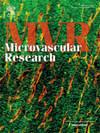Time-course and pressure-dependent changes in microvascular responses during ischemic preconditioning
IF 2.7
4区 医学
Q2 PERIPHERAL VASCULAR DISEASE
引用次数: 0
Abstract
This investigation examined a moderate individualized pressure (i.e., percentage of total arterial occlusion pressure [TAOP]) compared to low and high absolute pressures on muscle tissue oxygenation (StO2) throughout ischemic preconditioning (IPC). Fifteen males randomly completed three cycles of IPC at a low (20 mmHg [IPCSHAM]), moderate (80% of TAOP [IPC80%]), and high (220 mmHg [IPC220mmHg]) pressure. Each cycle lasted 5 min at the assigned pressure, followed by 5 min of zero pressure on the dominant leg. StO2 was measured continuously and StO2 indices (i.e., downslope [StO2down], minimum [StO2min], upslope [StO2up], maximum [StO2max]) were analyzed with Bayesian models. StO2down and StO2min were pressure-dependent (IPCSHAM < IPC80% < IPC220mmHg) as indicated by zero absent from all 95% high-density intervals (95% HDI) and 100% probability of an effect (Prob = 100%). During IPC220mmHg, StO2up increased from cycle 1 to cycles 2 and 3 but plateaued from cycle 2 to 3 as indicated by zero absent from all 95% HDI's and Prob ≥87.6%. Additionally, StO2up was greater for IPC80% and IPC220mmHg relative to IPCSHAM for cycles 1 and 2 but was pressure-dependent during cycle 3 as indicated by zero absent from all 95% HDI's and Prob = 98.8%. Lastly, StO2max was greater for IPC220mmHg than IPCSHAM and IPC80% as indicated by zero absent from all 95% HDI's and Prob = 100%. Collectively, using moderate individualized pressure elicited similar StO2up as high absolute pressure, but only for cycles 1 and 2. These findings may be attributed to differences in the hypoxic-insult and/or vascular-related mechano-transduction stimuli.
缺血预处理期间微血管反应的时间过程和压力依赖性变化。
本研究检查了在缺血预处理(IPC)过程中,与肌肉组织氧合(StO2)的低和高绝对压力相比,适度的个体化压力(即动脉闭塞压[TAOP]的百分比)。15名男性随机在低(20 mm Hg [IPCSHAM])、中(80 % TAOP [IPC80%])和高(220 mm Hg [IPC220mmHg])压力下完成3个IPC周期。在指定压力下,每个循环持续5 min,然后在优势腿上进行5 min的零压力。连续测量StO2,用贝叶斯模型分析StO2指数(即下坡[StO2down]、最小[StO2min]、上坡[StO2up]、最大值[StO2max])。StO2down和StO2min是压力依赖性的(IPCSHAM 80% 220mmHg),由所有95 %高密度区间(95 % HDI)的零缺失和100 %影响概率(Prob = 100 %)表示。在IPC220mmHg期间,StO2up从循环1到循环2和3增加,但从循环2到3趋于平稳,所有95 % HDI和Prob≥87.6% %均为零。此外,在循环1和2中,相对于IPCSHAM, IPC80%和IPC220mmHg的StO2up更大,但在循环3中,所有95 % HDI和Prob = 98.8 %中都不存在零,这表明StO2up在压力依赖性。最后,IPC220mmHg的StO2max大于IPCSHAM和IPC80%,所有95个 % HDI和Prob中均为零, = 100 %。总的来说,使用适度的个例压力会引起与高绝对压力相似的StO2up,但仅适用于循环1和2。这些发现可能归因于缺氧损伤和/或血管相关的机械传导刺激的差异。
本文章由计算机程序翻译,如有差异,请以英文原文为准。
求助全文
约1分钟内获得全文
求助全文
来源期刊

Microvascular research
医学-外周血管病
CiteScore
6.00
自引率
3.20%
发文量
158
审稿时长
43 days
期刊介绍:
Microvascular Research is dedicated to the dissemination of fundamental information related to the microvascular field. Full-length articles presenting the results of original research and brief communications are featured.
Research Areas include:
• Angiogenesis
• Biochemistry
• Bioengineering
• Biomathematics
• Biophysics
• Cancer
• Circulatory homeostasis
• Comparative physiology
• Drug delivery
• Neuropharmacology
• Microvascular pathology
• Rheology
• Tissue Engineering.
 求助内容:
求助内容: 应助结果提醒方式:
应助结果提醒方式:


